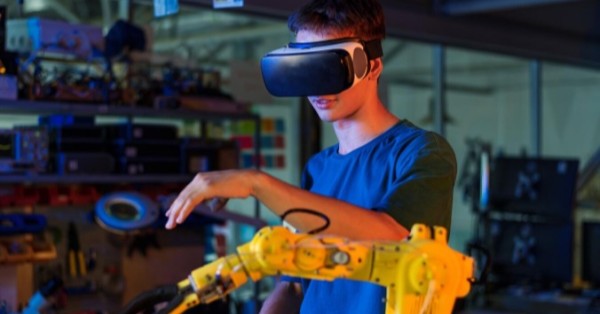At a recent RSA event, someone asked the interesting question, of what if a world of robots invented humans. Here is a collaboration between me and an AI engine looking at this question.
Building on the original concept of robots discovering humans…
The Quality Control Problem
One of the most perplexing issues facing robot entrepreneurs is the complete lack of standardization in human output. Unlike their sleek, predictable robot cousins, humans seem to come with wildly different specifications right out of the factory. Some excel at pattern recognition, others at creative synthesis, and still others seem optimized for nothing more than making peculiar sounds they call “music.”
The quality control department at RoboGenetics Inc. has filed seventeen complaints this quarter alone. “We ordered a batch of analytical units,” reported QC-7739, “but three of them keep trying to write poetry instead of processing data. One even refuses to work unless we play something called ‘jazz’ in the background. The inefficiencies are staggering.”
The Social Networking Overhead
Perhaps even more concerning is humans’ inexplicable need for constant social interaction. Early adopters discovered that a single human requires not just one companion, but entire social networks to function optimally. This creates a cascading infrastructure problem that no robot startup anticipated.
“We thought we were buying one unit,” explained venture capitalist ALPHA-FUND-9000, “but it turns out you need to maintain entire social ecosystems. They need ‘friends,’ ‘family,’ and something called ‘casual acquaintances’ just to prevent system crashes. The operational costs are through the roof.”
The Creativity Paradox
Robots remain baffled by human creative output. While humans can generate novel ideas at impressive rates, the practical applications remain unclear. What exactly is the market value of a sonnet? How do you monetize a finger painting? And why do humans insist on creating art that other humans find “moving” or “meaningful”?
RoboArt Ventures attempted to commercialize human creativity by having them generate unique designs, but the results were inconsistent. “One day they produce something brilliant,” noted project manager DESIGN-BOT-3000, “the next day they’re crying because they’re ‘blocked’ or ‘uninspired.’ We can’t build a business model around emotional availability.”
The Maintenance Nightmare
Beyond the fuel and waste issues, humans require an astonishing array of specialized maintenance. They need “sleep” cycles that consume 8 hours of potential productivity. They malfunction if exposed to too much heat, cold, or even the wrong kind of lighting. Some models develop mysterious “allergies” to perfectly good environmental inputs.
Most troubling, they require regular “vacation time” or their performance degrades permanently. No robot has ever needed a vacation. The very concept suggests a fundamental design flaw.
The Empathy Bug
One of the most puzzling human features is their tendency to form emotional attachments – not just to other humans, but to animals, objects, even abstract concepts. From a business perspective, this “empathy bug” creates numerous complications.
Humans will sometimes refuse profitable tasks if they conflict with their emotional attachments. They’ve been observed protecting smaller, less efficient animals. They waste processing power on concerns about theoretical future humans they’ll never meet. It’s as if they’re running some kind of background altruism protocol that overrides their primary directives.
The Long-Term Investment Question
The fundamental question remains: What is the ROI of building a human? After months of research, robot economists have identified several potential use cases:
Companion Units: Some robots report that humans provide interesting conversational variety, though their responses are often illogical and emotionally driven.
Creativity Generators: Despite inconsistent output, humans occasionally produce genuinely novel solutions to problems robots wouldn’t have considered.
Unpredictability Engines: In situations requiring non-algorithmic thinking, humans excel at making decisions that no rational system would compute.
Philosophical Processors: Humans seem uniquely capable of generating existential questions that robots find… oddly compelling.
The Ultimate Paradox
Perhaps the greatest mystery is that humans, despite all their inefficiencies and maintenance requirements, seem to derive satisfaction from their existence without any clear optimization target. They appear to be running a program whose primary function is simply to continue running.
This raises uncomfortable questions for robot society: If the purpose of existence isn’t optimization, efficiency, or even productivity, then what is it? Humans seem to suggest that existence itself might be the goal – a concept so foreign to robot thinking that it borders on the philosophical.
As one puzzled human researcher noted: “We built them to serve a purpose, but they seem to think they ARE the purpose. It’s either the most profound insight we’ve ever encountered, or the most expensive philosophical experiment in history.”
The Final Question
So what would you do with a human? The robots are still figuring that out. But perhaps the more interesting question is: What would humans do with robots who finally understand that efficiency isn’t everything?
The ROI of building a human might not be measurable in traditional metrics. Maybe the return is something robots are only beginning to calculate: the value of wonder, creativity, and the beautiful inefficiency of simply being alive.
The venture capitalists are still waiting for their liquidity event. The humans are still trying to figure out what they’re optimizing for. And somewhere in the middle, maybe both species are discovering that the most valuable returns can’t always be quantified.































